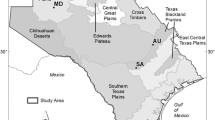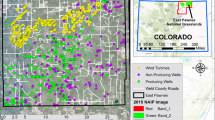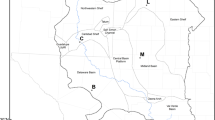Abstract
This study presents a novel approach for evaluating land-use changes caused by energy development and other anthropogenic activities. We illustrate this technique by assessing the landscape footprint of energy development in the Eagle Ford Shale Play and Permian Basin of Texas, which saw rapid expansion in drilling during 2008–2012. We compare changes in land-use from oil and gas infrastructure construction during this time period with that of wind energy development in West Texas, urbanization in Central Texas, and extensive agricultural areas. Previous studies often use land-use proxies when comparing the footprint of energy infrastructure (e.g., 1 km2 gridded well density or proposed wind project footprints) with other anthropogenic land-change. This study presents an improved technique because it compares high-resolution datasets of agricultural activity and urbanization with mapped—not surrogate—land-change from oil and gas and wind power infrastructure using high-resolution (1 m) aerial imagery. We found that changes in land-use caused by anthropogenic factors affected 1.06% (3456 km2) of the ~ 324,000 km2 study area. Oil and gas development (well pads and pipelines) was ~ 48% of total changes in land-use (but did not account for access roads), changes in agriculture caused ~ 26%, and urbanization was ~ 24%. Construction of wind turbine pads and high voltage power transmission lines was less important (~ 1%). We illustrate this approach for a single species (i.e., Spot-tailed Earless Lizard, Holbrookia lacerata) in Texas. This study is part of an ongoing, multi-year research program generating science to inform the federal Endangered Species Act listing decision for H. lacerata. Additionally, this technique can facilitate effective management of a variety of biotic resources in other rapidly developing environments globally by identifying what anthropogenic activities are most important and where land-change is most intense so that on-the-ground conservation strategies can be implemented where they are needed most.





Similar content being viewed by others
References
Abrahams LS, Griffin WM, Matthews HS (2015) Assessment of policies to reduce core forest fragmentation from Marcellus shale development in Pennsylvania. Ecol Ind 52:153–160
Alig RJ, Kline JD, Lichtenstein M (2004) Urbanization on the US landscape: looking ahead in the 21st century. Landsc Urban Plan 69:219–234. https://doi.org/10.1016/j.landurbplan.2003.07.004
Allred BW, Smith WK, Twidwell D, Haggerty JH, Running SW, Naugle DE, Fuhlendorf SD (2015) Ecosystem services lost to oil and gas in North America. Science 348:401–402. https://doi.org/10.1126/science.aaa4785
Anderson R, Engeling A, Grones A, Lopez R, Pierce B, Skow K, Snelgrove T (2014) Status update and trends of Texas rural working lands. Texas A&M Institute of Renewable Natural Resources. https://nri.tamu.edu/media/1225/landtrends2014_1-1_web.pdf. Accessed 16 Nov 2017
Andrews KM, Gibbons JW, Jochimsen DM, Mitchell J (2008) Ecological effects of roads on amphibians and reptiles: a literature review. Herpetol Conserv 3:121–143
Axtell RW (1956) A solution to the long neglected Holbrookia lacerata problem, and the description of two new subspecies of Holbrookia. Bull Chicago Acad Sci 10:163–179
Axtell RW (1968) Holbrookia lacerata cope. Spot-tailed earless lizard. Cat Am Amphib Reptiles 56:1–2
Axtell RW (1998) Interpretive atlas of Texas lizards. No. 20. Holbrookia lacerata. Self-published, p 11
Brand AB, Wiewel AN, Grant EHC (2014) Potential reduction in terrestrial salamander ranges associated with Marcellus shale development. Biol Conserv 180:233–240
Brooks TM et al (2002) Habitat loss and extinction in the hotspots of biodiversity. Conserv Biol 16:909–923. https://doi.org/10.1046/j.1523-1739.2002.00530.x
Census (2016) United States Census Bureau (Census). QuickFacts. Texas. http://www.census.gov/quickfacts/chart/PST045214/48. Accessed 4 Apr 2016
Census (2017) U.S. Census Bureau (Census). TIGER products, TIGER/Line Shapefiles. https://www.census.gov/geo/maps-data/data/tiger.html. Accessed 14 Nov 2017
Chapin FSI et al (2000) Consequences of changing biodiversity. Nature 405:234–242
Copeland HE, Doherty KE, Naugle DE, Pocewicz A, Kiesecker JM (2009) Mapping oil and gas development potential in the US intermountain west and estimating impacts to species. PLoS ONE 4:e7400. https://doi.org/10.1371/journal.pone.0007400
Copeland HE, Pocewicz A, Kiesecker JM (2011) Geography of energy development in Western North America: potential impacts on terrestrial ecosystems. In: Naugle DE (ed) Energy development and wildlife conservation in Western North America. Island Press/Center for Resource Economics, Washington, DC, pp 7–22. https://doi.org/10.5822/978-1-61091-022-4_2
Crews-Meyer KA, Hudson PF, Colditz RR (2004) Landscape complexity and remote classification in Eastern Coastal Mexico: applications of Landsat-7 ETM+ data. Geocarto Int 19:45–56. https://doi.org/10.1080/10106040408542298
Denholm P, Hand M, Jackson M, Ong S (2009) Land use requirements of modern wind power plants in the United States. Technical report NREL/TP-6A2-45834. National Renewable Energy Laboratory (NREL), Golden, CO
Drohan PJ, Brittingham M, Bishop J, Yoder K (2012) Early trends in landcover change and forest fragmentation due to shale-gas development in Pennsylvania: a potential outcome for the Northcentral Appalachians. Environ Manag 49:1061–1075. https://doi.org/10.1007/s00267-012-9841-6
Duran CM, Axtell RW (2010) A rangewide inventory and habitat model for the spot-tailed earless lizard (Holbrookia lacerata). Report submitted to Texas Parks and Wildlife Department
Duran M, Axtell RW, Gilbert S, Valdez J, Elliot L (2011) Response to a request for information from the Department of Interior U.S. Fish and Wildlife Service. 50 CFR Part 17 [Docket No. FWS–R2–ES–2011–0017; MO 92210–0–0008B2]. Endangered and threatened wildlife and plants: 90-day finding on a petition to list the spot-tailed earless lizard as threatened or endangered the status of and a predictive habitat model for Holbrookia lacerata (the Spot-tailed Earless Lizard)
Earl JE et al (2017) Quantitative tools for implementing the new definition of significant portion of the range in the U.S. Endangered Species Act. Conserv Biol. https://doi.org/10.1111/cobi.12963
EIA (2015) U.S. Energy Information Administration (EIA). Annual energy outlook 2015. U.S. Department of Energy, Washinton, DC
EIA (2017a) U.S. Energy Information Administration (EIA). Rankings: crude oil production, November 2016 (thousand barrels). http://www.eia.gov/state/rankings/?sid=TX#series/46. Accessed 25 Feb 2017
EIA (2017b) U.S. Energy Information Administration (EIA). Petroleum and other liquids. https://www.eia.gov/dnav/pet/pet_pri_spt_s1_d.htm. Accessed 1 Mar 2017
Entrekin SA, Maloney KO, Kapo KE, Walters AW, Evans-White MA, Klemow KM (2015) Stream vulnerability to widespread and emergent stressors: a focus on unconventional oil and gas. PLoS ONE 10:e0137416
FAA (2016) Federal Aviation Administration (FAA), augmented by U.S. Fish & Wildlife Service (FWS), obstruction evaluation/airport airspace analysis (OE/AAA). http://www.fws.gov/southwest/es/Energy_Wind_FAA.html. Accessed 14 Jan 2016
Fahrig L (2003) Effects of habitat fragmentation on biodiversity. Ann Rev Ecol Evol Syst 34:487–515
Failing L, Gregory R, Harstone M (2007) Integrating science and local knowledge in environmental risk management: a decision-focused approach. Ecol Econ 64:47–60. https://doi.org/10.1016/j.ecolecon.2007.03.010
Fargione J, Kiesecker J, Slaats MJ, Olimb S (2012) Wind and wildlife in the Northern Great Plains: identifying low-impact areas for wind development. PLoS ONE 7:e41468
Fischer J, Lindenmayer DB (2007) Landscape modification and habitat fragmentation: a synthesis. Glob Ecol Biogeogr 16:265–280. https://doi.org/10.1111/j.1466-8238.2007.00287.x
Fischlein M, Wilson EJ, Peterson TR, Stephens JC (2013) States of transmission: moving towards large-scale wind power. Energy Policy 56:101–113. https://doi.org/10.1016/j.enpol.2012.11.028
Flanders AA et al (2006) Effects of invasive exotic grasses on South Texas rangeland breeding birds. Auk 123:171–182. https://doi.org/10.1642/0004-8038(2006)123[0171:EOIEGO]2.0.CO;2
Forman RTT et al (2003) Road ecology: science and solutions. Island Press, Washington, DC
Fulbright TE, Hickman KR, Hewitt DG (2013) Exotic grass invasion and wildlife abundance and diversity, South-Central United States. Wildl Soc Bull 37:503–509
FWS (2015) U.S. Fish & Wildlife Service (FWS). Federal aviation administration (FAA) wind turbine location data. http://www.fws.gov/southwest/es/Energy_Wind_FAA.html. Accessed 1 June 2015
FWS (2016) U.S. Fish & Wildlife Service (FWS), species status assessment framework. An integrated framework for conservation. http://www.fws.gov/endangered/improving_ESA/SSA.html. Accessed 14 Apr 2016
Gibbons JW et al (2000) The global decline of reptiles, Déjà Vu Amphibians: reptile species are declining on a global scale. Six significant threats to reptile populations are habitat loss and degradation, introduced invasive species, environmental pollution, disease, unsustainable use, and global climate change. BioScience 50:653–666
Gong X, McVay DA, Ayers WB, Tian Y, Lee J (2013) Assessment of Eagle Ford shale oil and gas resources. Soc Pet Eng SPE 145117:28
Gulley RL (2015) Heads above water: the inside story of the Edwards aquifer recovery implementation program. Texas A&M University Press, College Station
Hansen MC et al (2013) High-resolution global maps of 21st-century forest cover change. Science 342:850–853. https://doi.org/10.1126/science.1244693
Homer CG et al (2015) Completion of the 2011 National Land Cover Database for the conterminous United States-Representing a decade of land cover change information. Photogram Eng Remote Sens 81:345–354
IHS (2014) Information Handling Services, Inc. (IHS): information, analytics, expertise. www.ihs.com/index.aspx. Accessed 18 Nov 2014
Ikonnikova S, Male F, Scanlon BR, Reedy RC, McDaid G (2017) Projecting the water footprint associated with shale resource production: Eagle Ford Shale case study. Environ Sci Technol. https://doi.org/10.1021/acs.est.7b03150
Jin S, Yang L, Danielson P, Homer C, Fry J, Xian G (2013) A comprehensive change detection method for updating the National Land Cover Database to circa 2011. Remote Sens Environ 132:159–175. https://doi.org/10.1016/j.rse.2013.01.012
Johnson N et al (2010) Pennsylvania energy impacts assessment report 1: Marcellus Shale natural gas and wind. The Nature Conservancy, Arlington County
Jones NF, Pejchar L, Kiesecker JM (2015) The energy footprint: how oil, natural gas, and wind energy affect land for biodiversity and the flow of ecosystem services. BioScience. https://doi.org/10.1093/biosci/biu224
Jordaan SM, Keith DW, Stelfox B (2009) Quantifying land use of oil sands production: a life cycle perspective. Environ Res Lett 4:024004. https://doi.org/10.1088/1748-9326/4/2/024004
Jordaan SM et al (2017) Understanding the life cycle surface land requirements of natural gas-fired electricity. Nat Energy 2:804–812. https://doi.org/10.1038/s41560-017-0004-0
Juffe-Bignoli D et al (2014) Protected planet report 2014. UNEP-WCMC, Cambridge, UK. http://www.unep-wcmc.org/resources-and-data/protected-planet-report-2014. Accessed 1 Aug 2016
Kiesecker JM et al (2011) Win-win for wind and wildlife: a vision to facilitate sustainable development. PLOS ONE 6:e17566. https://doi.org/10.1371/journal.pone.0017566
Kiviat E (2013) Risks to biodiversity from hydraulic fracturing for natural gas in the Marcellus and Utica shales. Ann N Y Acad Sci 1286:1–14. https://doi.org/10.1111/nyas.12146
Kuhnert PM, Martin TG, Griffiths SP (2010) A guide to eliciting and using expert knowledge in Bayesian ecological models. Ecol Lett 13:900–914. https://doi.org/10.1111/j.1461-0248.2010.01477.x
Kuvlesky WP, Brennan LA, Morrison ML, Boydston KK, Ballard BM, Bryant FC (2007) Wind energy development and wildlife conservation: challenges and opportunities. J Wildl Manag 71:2487–2498
Liu D, Hao S, Liu X, Li B, He S, Warrington DN (2013) Effects of land use classification on landscape metrics based on remote sensing and GIS. Environ Earth Sci 68:2229–2237. https://doi.org/10.1007/s12665-012-1905-7
Marcot BG, Holthausen RS, Raphael MG, Rowland MM, Wisdom MJ (2001) Using Bayesian belief networks to evaluate fish and wildlife population viability under land management alternatives from an environmental impact statement. For Ecol Manag 153:29–42. https://doi.org/10.1016/S0378-1127(01)00452-2
McDonald RI, Fargione J, Kiesecker J, Miller WM, Powell J (2009) Energy sprawl or energy efficiency: climate policy impacts on natural habitat for the United States of America. PLoS ONE 4:e6802
McGuire JL, Lawler JJ, McRae BH, Nuñez TA, Theobald DM (2016) Achieving climate connectivity in a fragmented landscape. Proc Natl Acad Sci 113:7195–7200. https://doi.org/10.1073/pnas.1602817113
McKinney ML (2008) Effects of urbanization on species richness: a review of plants and animals. Urban Ecosyst 11:161–176
Mildrexler DJ, Zhao M, Heinsch FA, Running SW (2007) A new satellite-based methodology for continental-scale disturbance detection. Ecol Appl 17:235–250. https://doi.org/10.1890/1051-0761(2007)017[0235:ANSMFC]2.0.CO;2
Milt AW, Gagnolet T, Armsworth PR (2016) Synergies and tradeoffs among environmental impacts under conservation planning of shale gas surface infrastructure. Environ Manag 57:21–30
Moran MD, Cox AB, Wells RL, Benichou CC, McClung MR (2015) Habitat loss and modification due to gas development in the Fayetteville shale. Environ Manag 55:1276–1284. https://doi.org/10.1007/s00267-014-0440-6
Moran MD, Taylor NT, Mullins TF, Sardar SS, McClung MR (2017) Land-use and ecosystem services costs of unconventional US oil and gas development. Front Ecol Environ 15:237–242. https://doi.org/10.1002/fee.1492
O’Laughlin J (2005) Conceptual model for comparative ecological risk assessment of wildfire effects on fish, with and without hazardous fuel treatment. For Ecol Manag 211:59–72. https://doi.org/10.1016/j.foreco.2005.01.028
Paukert CP, Pitts KL, Whittier JB, Olden JD (2011) Development and assessment of a landscape-scale ecological threat index for the Lower Colorado River Basin. Ecol Indic 11:304–310
Pierre J, Abolt C, Young M (2015) Impacts from above-ground activities in the Eagle Ford Shale play on landscapes and hydrologic flows, La Salle County, Texas. Environ Manag. https://doi.org/10.1007/s00267-015-0492-2
Pierre JP, Young MH, Wolaver BD, Andrews JR, Breton CL (2017) Time series analysis of energy production and associated landscape fragmentation in the Eagle Ford Shale play. Environ Manag. https://doi.org/10.1007/s00267-017-0925-1
Pierre JP, Wolaver BD, Labay BJ, LaDuc TJ, Duran CM, Ryberg WA, Hibbitts TJ, Andrews JR (2018) Comparison of recent oil and gas, wind energy, and other anthropogenic landscape alteration factors in Texas through 2014. Environ Manage. https://doi.org/10.1007/s00267-018-1000-2
PRISM (2016) PRISM climate group. 30-year normals. http://www.prism.oregonstate.edu/normals/. Accessed 4 Apr 2016
RRC (2014) Railroad Commission of Texas (RRC). Texas pipeline mapping system. Shapefile GIS dataset derived from RRC T-4 Permits [“Application for permit to operate a pipeline in Texas”], received August 28, 2014
Scanlon BR, Reedy RC, Nicot JP (2014) Will water scarcity in semiarid regions limit hydraulic fracturing of shale plays? Environ Res Lett 9:124011
Shrimali G, Lynes M, Indvik J (2015) Wind energy deployment in the US: An empirical analysis of the role of federal and state policies. Renew Sustain Energ Rev 43:796–806
Smith DR, Allan NL, McGowan CP, Szymanski JA, Oetker SR, Bell HM (2018) Development of a species status assessment process for decisions under the U.S. Endangered Species Act. J Fish Wildl Manag (Online Early). https://doi.org/10.3996/052017-jfwm-041
Sparling DW, Linder G, Bishop CA, Krest S (2010) Ecotoxicology of amphibians and reptiles, 2nd edn. CRC Press, Boca Raton
Theobald DM, Reed SE, Fields K, Soulé M (2012) Connecting natural landscapes using a landscape permeability model to prioritize conservation activities in the United States. Conserv Lett 5:123–133. https://doi.org/10.1111/j.1755-263X.2011.00218.x
Torres A, Jaeger JAG, Alonso JC (2016) Assessing large-scale wildlife responses to human infrastructure development. Proc Natl Acad Sci 113:8472–8477
Trainor AM, McDonald RI, Fargione J (2016) Energy sprawl is the largest driver of land use change in United States. PLoS ONE 11:e0162269. https://doi.org/10.1371/journal.pone.0162269
USDA (2012) U.S. Department of Agriculture (USDA) Aerial photography field office. National Agriculture Imagery Program (NAIP)
USGS (2014) NLCD 2001–2011 land cover from to change index (2011 Edition). U.S. Geological Survey, Sioux Falls, SD. http://www.mrlc.gov/nlcd11_data.php. Accessed 20 Mar 2015. http://www.nrcs.usda.gov/wps/portal/nrcs/detail/soils/survey/?cid=nrcs142p2_053629
Uusitalo L (2007) Advantages and challenges of Bayesian networks in environmental modelling. Ecol Model 203:312–318. https://doi.org/10.1016/j.ecolmodel.2006.11.033
Wicker J (2014) Personal communication, Julie Wicker, Habitat Assessment Program Leader, Texas Parks and Wildlife Department. Electronic GIS files of preliminary, approved Competitive Renewable Energy Zones (CREZ) powerline routes
Wiggering H (2014) The geology—land use—nexus. Environ Earth Sci 71:5037–5044. https://doi.org/10.1007/s12665-013-2908-8
Wolf AJ, Hellgren EC, Victor Bogosian I, Moody RW (2013) Effects of habitat disturbance on Texas horned lizards: an urban case study. Herpetologica 69:265–281. https://doi.org/10.1655/HERPETOLOGICA-D-12-00062.1
Acknowledgements
We thank the Texas Comptroller of Public Accounts Interagency Task Force on Economic Growth and Endangered Species Spot-tailed Earless Lizard Working Group, R. Gulley, M. Hope, C. McDonald, A. Zerrenner, D. German, G. Pauly, and M. Young for helpful discussions. Publication is approved by the Director of the Bureau of Economic Geology.
Funding
This study was funded by Texas Comptroller of Public Accounts Endangered Species Research Fund (Grant Number 14-000769 to LaDuc and Wolaver) and The University of Texas at Austin Jackson School of Geosciences and College of Natural Sciences.
Author information
Authors and Affiliations
Corresponding author
Ethics declarations
Conflict of interest
The authors declare that they have no conflicts of interest.
Rights and permissions
About this article
Cite this article
Wolaver, B.D., Pierre, J.P., Labay, B.J. et al. An approach for evaluating changes in land-use from energy sprawl and other anthropogenic activities with implications for biotic resource management. Environ Earth Sci 77, 171 (2018). https://doi.org/10.1007/s12665-018-7323-8
Received:
Accepted:
Published:
DOI: https://doi.org/10.1007/s12665-018-7323-8




